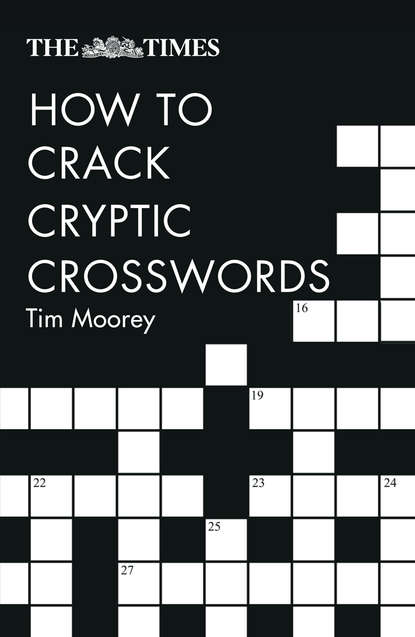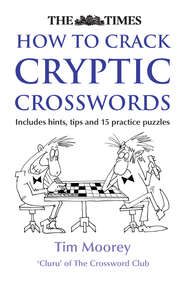По всем вопросам обращайтесь на: info@litportal.ru
(©) 2003-2024.
✖
The Times How to Crack Cryptic Crosswords
Настройки чтения
Размер шрифта
Высота строк
Поля
12 Recommended Books, Websites & Media (#litres_trial_promo)
13 Practice Clues by Type (#litres_trial_promo)
14 Practice Puzzles (#litres_trial_promo)
15 Difficulty Ranking in Newspapers (#litres_trial_promo)
Part 4: (#litres_trial_promo)
Appendices (#litres_trial_promo)
1 List of Abbreviations (#litres_trial_promo)
2 Solutions: Practice Clues (#litres_trial_promo)
3 Solutions: Practice Puzzles (#litres_trial_promo)
4 Thanks (#litres_trial_promo)
Index (#litres_trial_promo)
About the Publisher (#litres_trial_promo)
Introduction (#ulink_a35f9c3f-95da-51f1-920c-664ee7e84878)
“In Victorian times a popular game was Magic Square… In 1913 Arthur Wynne was given the task of devising a new puzzle for the World. He adapted the magic square by blackening in some squares and criss-crossing the words. Thus was the first ever crossword puzzle created.”
The Advertiser, Adelaide
What’s the aim of this book?
I hope to show that, for any daily or weekly crossword puzzle, it is possible to improve your solving skills substantially by the study and application of a few straightforward rules and techniques.
So, is this book only for beginners?
Not at all, it is also for anyone wanting to master crossword puzzles so he or she isn’t regularly left with unfinished clues before the next day’s newspaper arrives. It may also appeal to others happy to enjoy many first-rate clues and practice puzzles from the sources that abound in the book.
Is there a typical person who might benefit?
Whilst I wouldn’t wish to deter others, the person who enjoys a daily struggle with a Quick (non-cryptic) crossword appearing in nearly every newspaper, is an ideal recruit to the world of cryptics. He or she will soon find that they are being given only one way of cracking a clue ie by definition only; cryptics more often than not have two ways, sometimes more, and take full advantage of the delights and richness of the English language.
What are my qualifications?
My experience as:
1 A (not very fast) solver of crosswords for over 60 years, starting with the London Evening News, followed by the Radio Times and the News Chronicle.
2 A crossword setter whose first crossword was published in the Evening News in 1956.
3 Author of How to Master The Times Crossword (HarperCollins 2008) which explained cryptic clues in innovative charts that have been well received and are again used in this book.
4 A tutor of crossword workshops around the country for adults and children for over 20 years.
Is this then an update of How to Master The Times Crossword?
Feedback on this first book showed that it proved useful for solving crosswords other than The Times. This encouraged me to write a generic book, How to Crack Cryptic Crosswords in 2014, applicable to just about any crossword with puzzles and clues from a variety of sources, not only The Times.
Is this then an update of How to Crack Cryptic Crosswords?
Yes it is, for the following reasons:
Practice being crucial, to give more solving opportunity via 24 all new puzzles from a variety of publications. Each is partnered by detailed explanations as to why answers are what they are;
It contains many new example clues explaining the basics even more clearly than before and uses the same explanatory diagrams that proved popular in my earlier books;
The update has been written after gaining from my workshops lots more experience of what new solvers find most helpful. To that end, many new clues should seem easier than their predecessors;
The launch of the Times Quick Cryptic. Smaller and easier than the main Times Crossword, this has proved to be an excellent puzzle for teaching newcomers and is used extensively in the present update;
There are many new internet sites and media outlets for cryptics.
My hope is that these features provide good reason for total newcomers and my previous readers of both books to enjoy and learn from this update.
Are there rules and conventions applying to all cryptic crosswords?
It surprises people to hear that there are, as set down by Ximenes (see box) and they are followed to a large extent by the clue writers and crossword setters whose work appears here.
So which crosswords are not covered?
Barred crosswords such as Mephisto (Sunday Times), Azed (Observer), the Inquisitor (the i), Beelzebub (the Independent on Sunday), Enigmatic Variations (Sunday Telegraph) and the Listener Crossword (in the Saturday Times) are not used as examples. Solvers of these puzzles at the top of the difficulty scale are not in need of instruction.
XIMENES AND AZED
Having taken his name from a Grand Inquisitor in the Spanish Inquisition, Ximenes (Derrick Macnutt), a Marlborough College student and Classics master at Christ’s Hospital, was long-term setter of a crossword puzzle in the Observer. He is remembered today, not just for his puzzles, but also because he set out fair and consistent principles for cryptic crosswords, design and clues in a ground-breaking 1966 book Ximenes on the Art of the Crossword, reissued in 2001. His successor Azed (Jonathan Crowther) and the majority of setters today in national media follow virtually all of what are known as ‘Ximenean’ principles. See here (#litres_trial_promo) for more on these.
What about Jumbo crosswords?
No examples of these puzzles are included on the grounds of space but the clueing and solving principles and practice described are just as relevant to their solvers.
What’s the book’s focus?
It’s firmly on the solver. The teaching sections have been written after consulting a large number of solver friends, colleagues, acquaintances and workshop students, much of whose experience and techniques are incorporated. To this end, a setter’s blog in the previous book is replaced by practice puzzles.
Are there rules for solving?
No, and I certainly would not wish to be seen as laying rules down. Everyone finds their own way of doing crosswords and my hope is that I help you to find yours. Also I invite you to adopt or reject the tips according to whether they suit you.
One thing I will point out, albeit hesitantly, is that on my workshops, female students tend to be ‘instinctive’ solvers (initial guess and work out why afterwards) whereas male students tend to be more ‘analytical’ in their initial solving. But that’s naturally not always the case: the key point is that it doesn’t matter which type you are.






